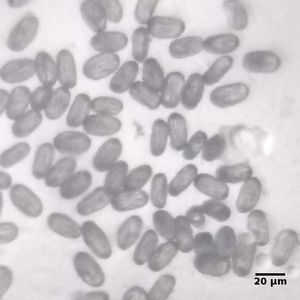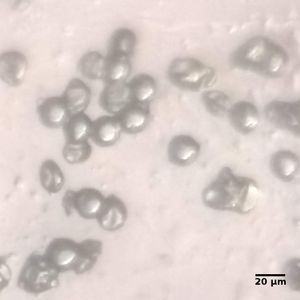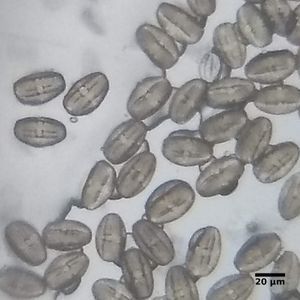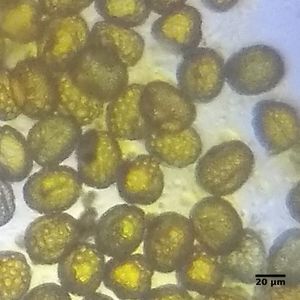Indian Laburnum pollen — a story of many anthers
 May 28, 2018 • 1:25 AM UTC
May 28, 2018 • 1:25 AM UTC Unknown Location
Unknown Location 140x Magnification
140x Magnification Microorganisms
Microorganisms
varuni
Learn about the author...
21posts
22comments
1locations
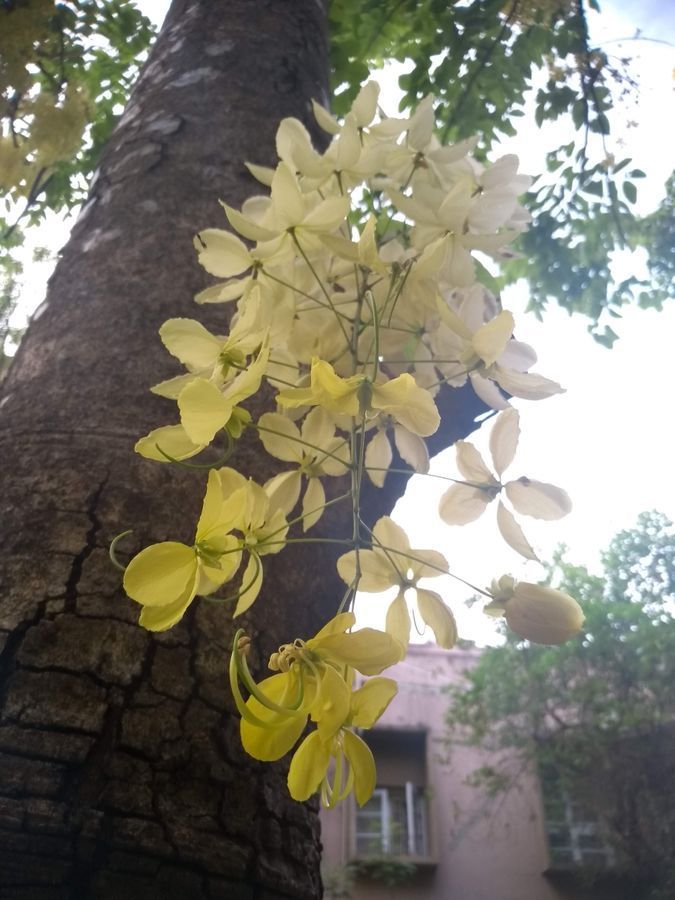
The Indian Laburnum ( Cassia fistula ) on campus are in full bloom!

Here’s a close up one of the flower cascades:

The paths on campus are strewn with flower parts:
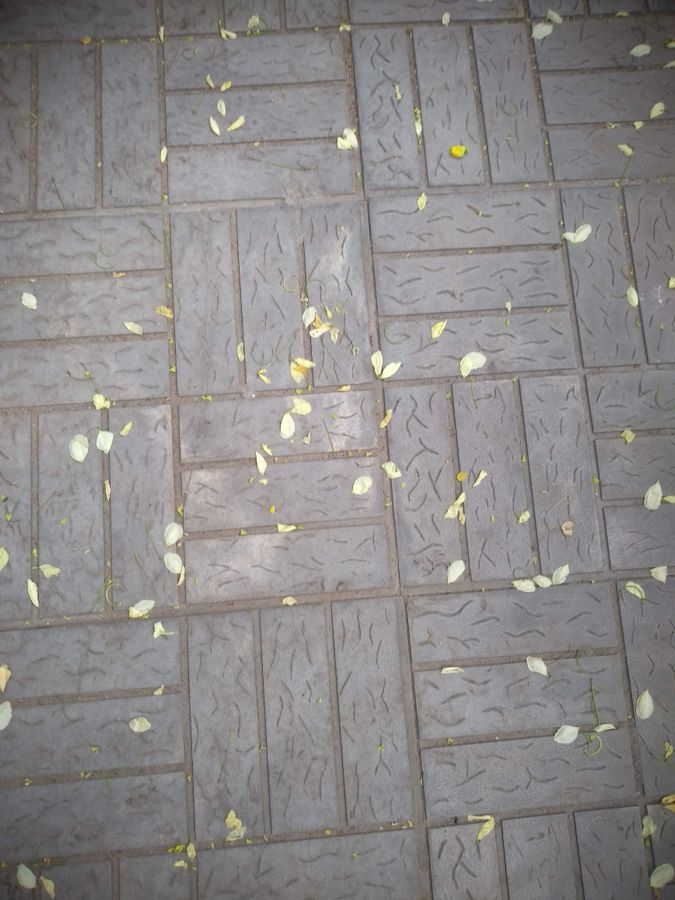
I picked up one of the fallen stamens and broke it open onto a slide:
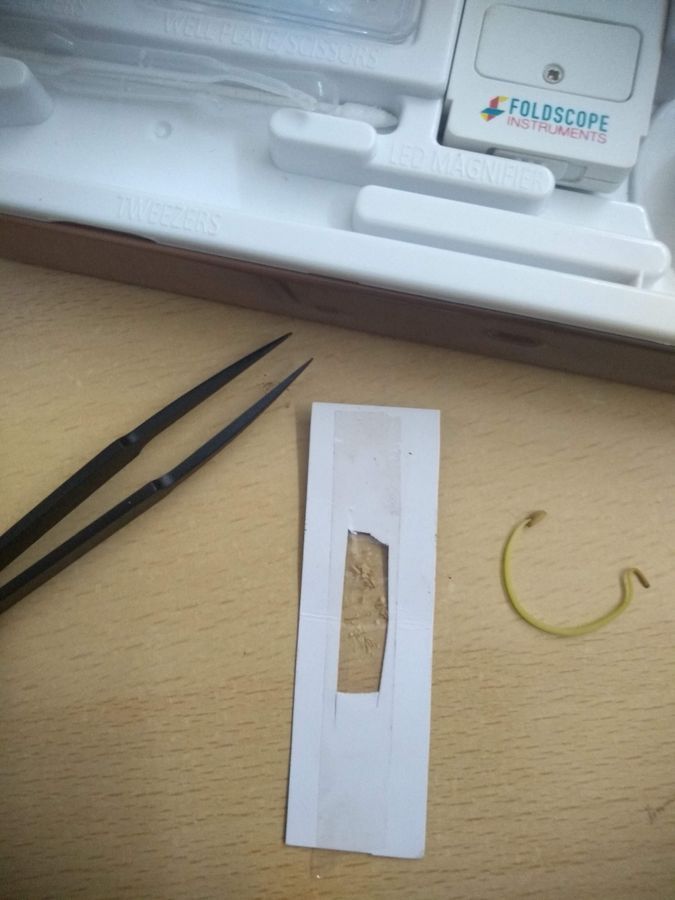
And voila, all this pollen split out:
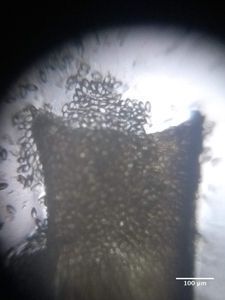
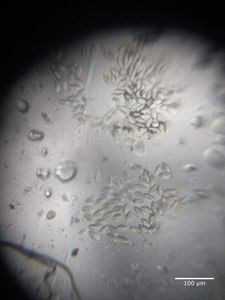
The pollen grains are ~30 microns in length:
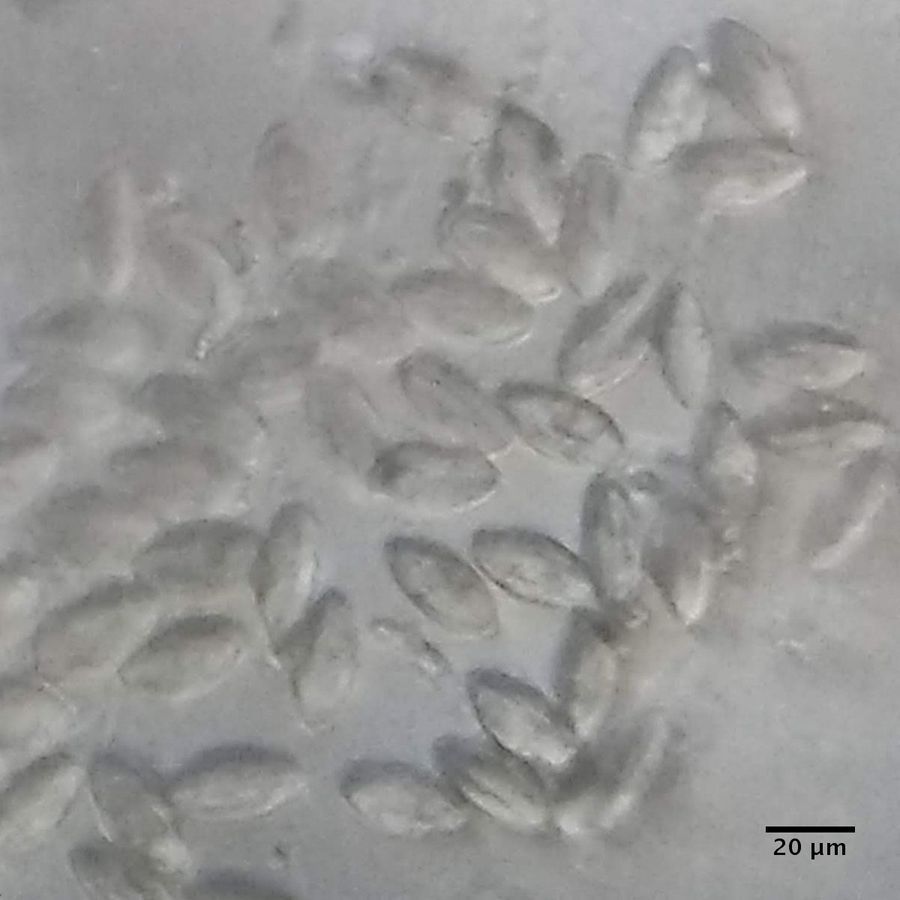
UPDATE: are there more types of pollen in this flower?
If you didn’t notice in the image of the flower cascade, you can see that the lowest open flower has different types of anthers. Can you find the different anthers in this image?
If you didn’t notice in the image of the flower cascade, you can see that the lowest open flower has different types of anthers. Can you find the different anthers in this image?

After what I observed in the Nagalingam flower , I am wondering if Laburnum has dimorphic pollen too?! Let me check it out and update the post soon…
UPDATE 2: pollen from different types of anthers!
I looked for the shorter stamens and couldn’t find any on the path — there were only long stamens! The flowers are too high up and all of the previous days flowers are neatly swept away by our campus gardeners every morning. So I’d have to come by later and hope one of the intact flowers falls…
But then, on my way out of campus, looking for intact flowers, to my surprise, I also found shorter stamens!
UPDATE 2: pollen from different types of anthers!
I looked for the shorter stamens and couldn’t find any on the path — there were only long stamens! The flowers are too high up and all of the previous days flowers are neatly swept away by our campus gardeners every morning. So I’d have to come by later and hope one of the intact flowers falls…
But then, on my way out of campus, looking for intact flowers, to my surprise, I also found shorter stamens!
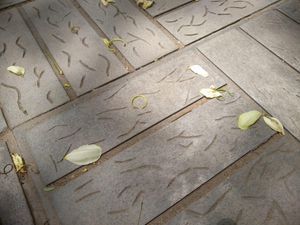
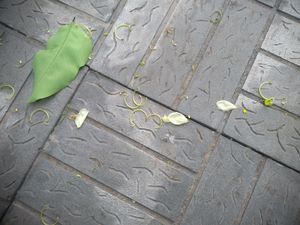
Compare the morning and evening paths — no small anthers in the morning! Maybe the different anthers wilt and fall at different times of the day?!
Anyway, I pocketed some of these shorter stamens. And just as I was walking by this WHOLE flower drifted down to the ground:
Anyway, I pocketed some of these shorter stamens. And just as I was walking by this WHOLE flower drifted down to the ground:
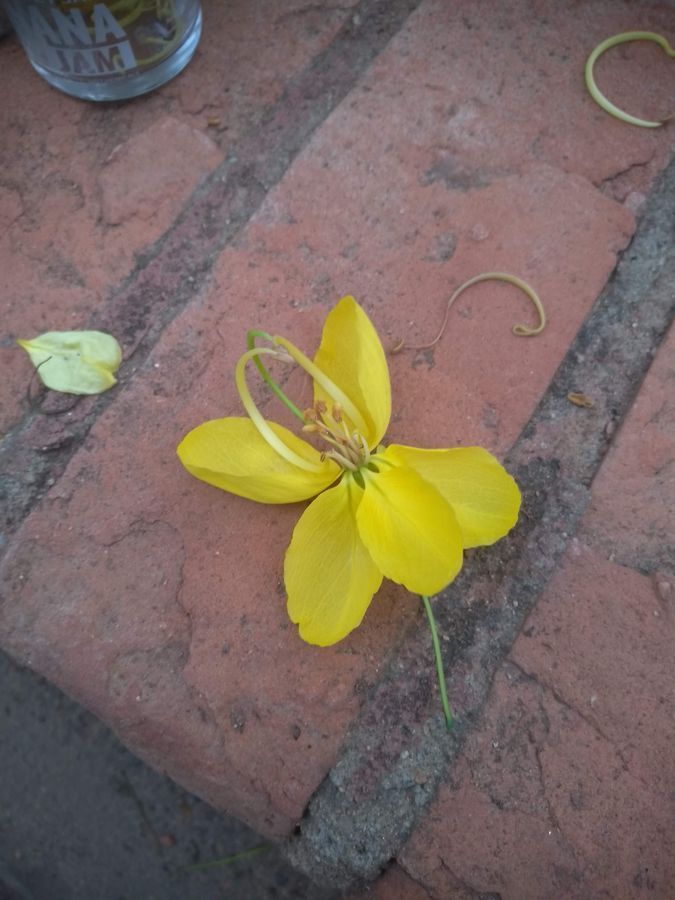
I carefully put it into a small box and I hurried home, excited to see TRImorphic pollen!!
Here are all the anthers of this flower:
Here are all the anthers of this flower:
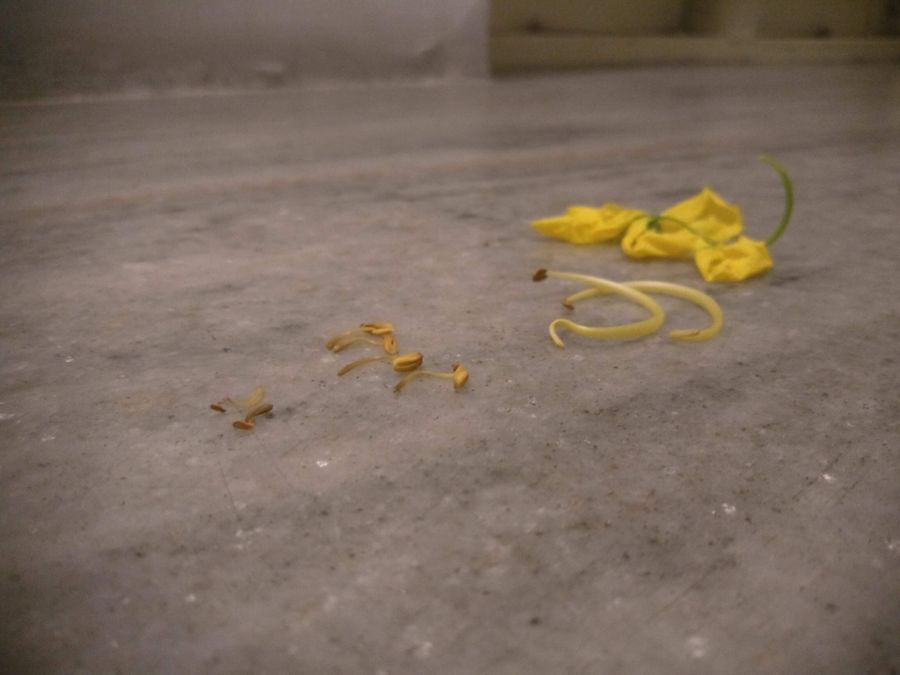
It has 8 stamens: 2 short, 4 medium and 2 large. (I guess there could have been more — its hard to tell if some fell off sometime during the day…)
I squashed one or two of each of the anther types onto different slides.
I squashed one or two of each of the anther types onto different slides.

And looked at them under the Foldscope:


Small anthers: very few pollen — possibly some sticky stuff around



Medium anthers: many pollen– with lots of sticky stuff around them. (Also some strange deflated looking pollen.)



Large anthers: many many pollen — no sticky stuff, pretty regular in shape and size. (Not sure what that spiny stuff is the first image is — perhaps a bee got entangled in it?)
The pollen from the different anthers are pretty much the same size too. Here they are (S, M, L) side by side:
The pollen from the different anthers are pretty much the same size too. Here they are (S, M, L) side by side:
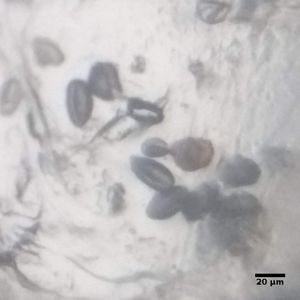
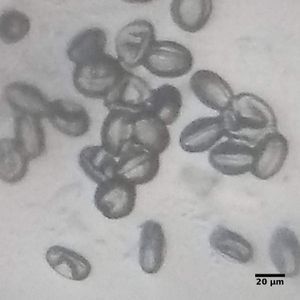
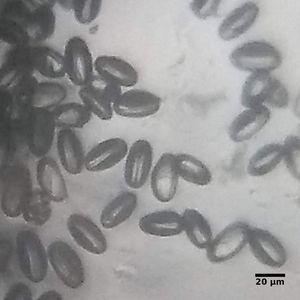
However, it seems like the small anthers have very new pollen and the medium anthers have more sticky stuff in them along with the pollen. Perhaps the small ones lost all their pollen already? Perhaps the medium anthers aren’t as dried out as the long anthers? Maybe the long anthers are non viable pollen?
I poked around the internet for a bit and I found some fascinating stuff. This journal article from a researcher in Argentina looked at heteranthery in Senna corymbosa , another member of Cassieae ( an evolutionarily fraught group — but thats a whole different story). The author describes the life a S. corymbosa flower (2 days) and how different parts of the flower mature at different times (including the heteromorphic anthers). She also says that the shorter anthers produce infertile pollen that bees forage (similar to the story of pollen from the hood anther in the
Nagalingam
flower ). While the pollen from different anthers do not have visible morphological differences, she shows that the shorter stamen pollen do not germinate — at least for the species she looked at. (Variation in pollen germination maybe something to try with our C. fistula pollen — seems like all you need is sugar, water, pollen and time. Maybe its a good experiment to try out with school students?)
The story doesn’t have a neat explanation like in case of the dimorphic pollen of the
Nagalingam
flower , but I think that makes it all the more interesting! There are many unanswered questions:
Are there more anthers? Do all pollen from all anthers germinate? If you dry them out (or get rid of the sticky stuff somehow), will all of the pollen look the same? What are those deflated pollen-looking things from the medium anthers? What are those spiny things around the large anther?? I also found this reference which seems like it will answer at least some of our questions:
S.E.M. studies of pollen in relation to enantiostyly and heteranthery in Cassia L. (Caesalpinaceae) by Bahadur B., A. Chatuverdi & N. Rama Swary from 1990 in the Journal of Palynology.
Unfortunately, I can’t find it online. Will have to find a physical library/person that has this and read it. Will update here about it if I do…
I addition to the slides, I saved me a jar of anthers, so I can revisit this story in a bit…
I poked around the internet for a bit and I found some fascinating stuff. This journal article from a researcher in Argentina looked at heteranthery in Senna corymbosa , another member of Cassieae ( an evolutionarily fraught group — but thats a whole different story). The author describes the life a S. corymbosa flower (2 days) and how different parts of the flower mature at different times (including the heteromorphic anthers). She also says that the shorter anthers produce infertile pollen that bees forage (similar to the story of pollen from the hood anther in the
Nagalingam
flower ). While the pollen from different anthers do not have visible morphological differences, she shows that the shorter stamen pollen do not germinate — at least for the species she looked at. (Variation in pollen germination maybe something to try with our C. fistula pollen — seems like all you need is sugar, water, pollen and time. Maybe its a good experiment to try out with school students?)
The story doesn’t have a neat explanation like in case of the dimorphic pollen of the
Nagalingam
flower , but I think that makes it all the more interesting! There are many unanswered questions:
Are there more anthers? Do all pollen from all anthers germinate? If you dry them out (or get rid of the sticky stuff somehow), will all of the pollen look the same? What are those deflated pollen-looking things from the medium anthers? What are those spiny things around the large anther?? I also found this reference which seems like it will answer at least some of our questions:
S.E.M. studies of pollen in relation to enantiostyly and heteranthery in Cassia L. (Caesalpinaceae) by Bahadur B., A. Chatuverdi & N. Rama Swary from 1990 in the Journal of Palynology.
Unfortunately, I can’t find it online. Will have to find a physical library/person that has this and read it. Will update here about it if I do…
I addition to the slides, I saved me a jar of anthers, so I can revisit this story in a bit…
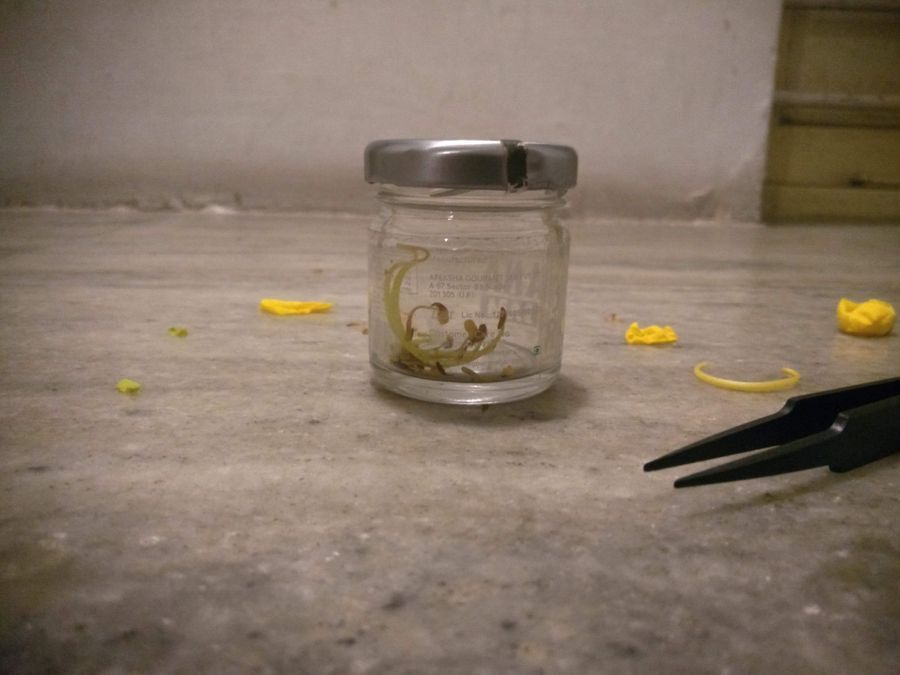
Stay tuned!!
Meanwhile, for cool pollen images, check out this paper for high resoultion SEM images of hereteroanthery and in this omic-age, what field is complete without a gene expression assay ?
Finally, if you just TLDR scrolled here, moral of the story: when you get pollen, notice how many anthers/types of anther there are and which anther you are getting pollen from 🙂
This post is open to read and review on The Winnower.
Meanwhile, for cool pollen images, check out this paper for high resoultion SEM images of hereteroanthery and in this omic-age, what field is complete without a gene expression assay ?
Finally, if you just TLDR scrolled here, moral of the story: when you get pollen, notice how many anthers/types of anther there are and which anther you are getting pollen from 🙂
This post is open to read and review on The Winnower.
Sign in to commentNobody has commented yet... Share your thoughts with the author and start the discussion!
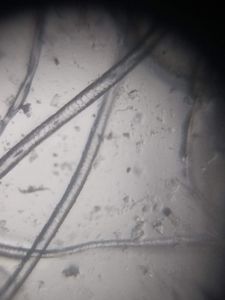
 0 Applause
0 Applause 0 Comments
0 Comments
